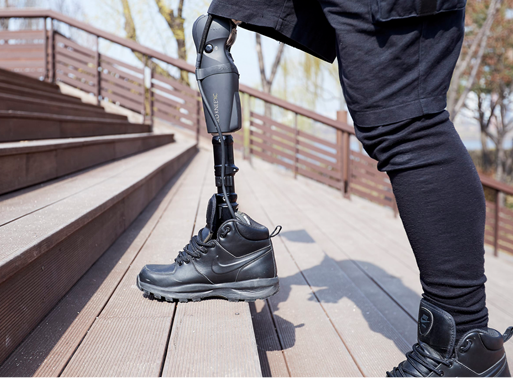כפות רגליים תותבות – Clinical studies of feet
In order of most recent publication first.
Heiðrun Gigja Ragnarsdóttir M.Sc., Hjordís Thorhallsdóttir, M.Sc., Knut Lechler, CPO-DComparison study: Symmetric versus asymmetric foot design.
Synopsis: This comparison study objectifiesthe effect of symmetric versus asymmetric foot desing on the progression of center of pressure in the medio-lateral directions. A design with variable medio-lateral characteristics was compared to the conventional symmetric foot design. Objective measurement equipment shows that the use of an asymmetric foot design results in a more natural roll-over of the foot module. Click here for full version (330Kb pdf).
Hafner, B. J., Sanders, J. E., Czerniecki, J. and Fergason, J. Energy storage and return prostheses: does patient perception correlate with biomechanical analysis? Clin Biomech (Bristol, Avon), 17, 325-44, 2002.
Synopsis: This is a literature review evaluating energy storage and return and conventional prosthetic feet presented in various studies. Results suggest that while experimental methodologies may limit the statistical significance of objective gait analysis results, consistent trends in temporal, kinetic, and kinematic parameters correlate well with perceptive impressions of DER feet. These correlations provide insight to subtle changes in gait parameters that are deemed neither clinically nor statistically significant, yet are perceived by amputees to affect their preference for and performance of prosthetic feet during locomotion. It is suggested how to design studies revealing more statistical significant results. The Flex-Foot was found to be superior in late stance dorsiflexion.
Hsu, M. J., Nielsen, D. H., Yack, H. J. and Shurr, D. G. Physiological measurements of walking and running in people with transtibial amputations with 3 different prostheses. J Orthop Sports Phys Ther, 29, 526-33, 1999.
Synopsis: The study compared three different feet (SACH,Modular III and Re-Flex) in walking at different speeds and running. Five young and active subjects were included in this test. The session were performed on a treadmill measuring energy cost per meter traveled(mL O2/kg/m)The Re-Flex VSP appears to have a positive effect on energy cost, gait efficiency, and relative exercise intensity compared with other prosthetic foot types during walking and running
Macfarlane, P., Nielson, D., Shurr, D., Meier, K., Clark, R., Kerns, J., Moreno, M. and Ryan, B. Transfemoral Amputee Physiological Requirements: Comparisons Between SACH Foot Walking and Flex-Foot Walking. Journal of Prosthetics and Orthotics, 9, 138-143, 1997.
Synopsis: This study compared exercise intensity, oxygen uptake and gait efficiency of five male subjects in two test sessions. Active traumatic transfemoral amputees used a SACH foot or a Flex-Foot" attached below a hydraulic knee joint. Walking on level surface at three different speeds was performed. Heart rate was recorded by telemetry, and expired gas was collected. The analysis indicate that the Flex-Foot was associated with significantly lower exercise intensity, less energy expenditure and improved gait efficiency compared to the SACH foot.
Snyder, R. D., Powers, C. M., Fontaine, C. and Perry, J. The effect of five prosthetic feet on the gait and loading of the sound limb in dysvascular below-knee amputees. J Rehabil Res Dev, 32, 309-15, 1995.
Synopsis: The study investigated the effects of prosthetic foot design on the vertical ground reaction forces experienced by the sound limb of seven dysvascular below-knee male amputees. Stride characteristics, joint motion, and ground reaction forces were recorded simultaneously during a self-selected free walking velocity in seven subjects wearing five different prosthetic feet (SACH, Flex-Foot, Carbon Copy II, Seattle, Quantum). The use of the Flex-Foot resulted in the lowest sound limb vertical forces, which appears to be related to its large arc of dorsiflexion motion. In addition, there was increased loading response knee flexion of the sound limb indicating an attempt by these subjects to modulate floor impact. This indicates the Flex-Foot protects the sound limb against excessive vertical forces by virtue of its flexible long keel and large arc of dorsiflexion motion.
Barth, D., Schumacher, L. and Sienko Thomas, S. Gait Analysis and Energy Cost of Below- Knee Amputees Wearing Six Different Prosthetic Feet. Journal of Prosthetics and Orthotics, 4, 63-75, 1992.
Synopsis: Comparison of sound-limb to prosthetic-limb symmetry is the used method to analyze and evaluate different prosthetic feet in this study. Six male vascular amputee showed they benefit from the high range of ankle motion of the Flex-Walk especially when walking inclines
Engsberg. JR, Macintosh. BR and JA, H. Comparison of Effort Between Below-Knee Amputee and Normal Children. Journal of the Association of Children's Prosthetic-Orthotic Clinics, 26, 46, 1991.
Synopsis: This is a preliminary investigation on a comparison of physiological and biomechanical measurements of three below-knee-amputee and two normal children. Oxygen uptake, heart rate and vertical displacement of a marker approximating the whole body center of mass were measured. One was fitted to a Flex foot and two wore a SACH foot. Measurements were taken on a treadmill in four different speeds. Results indicated the children with the SACH generally displayed greater effort for all walking speeds when compared to respective values of the normal children and the one fitted with the Flex-Foot.
Macfarlane, P., Nielsen, L. P. T., Ph.D. , Shurr, L. P. T., CO. and Meier, C. P. Perception of Walking Difficulty by Below-Knee Amputees Using a Conventional Foot Versus the Flex-Foot. Journal of Prosthetics and Orthotics, 3, 114-119, 1991.
Synopsis: The study on seven male unilateral BK amputees showed significantly differences on the subjects using an FF compared to a CF. It appears the increased length of time the subjects were willing to spend in single support on the FF as compared to the CF allows them to take larger, more normal steps with their uninvolved leg and, hence, they needed fewer steps per minute to match CF walking speeds. Walking with the Flex Foot was associated with a smoother, more uniform vertical trunk motion, suggesting an increase in biomechanical efficiency.


